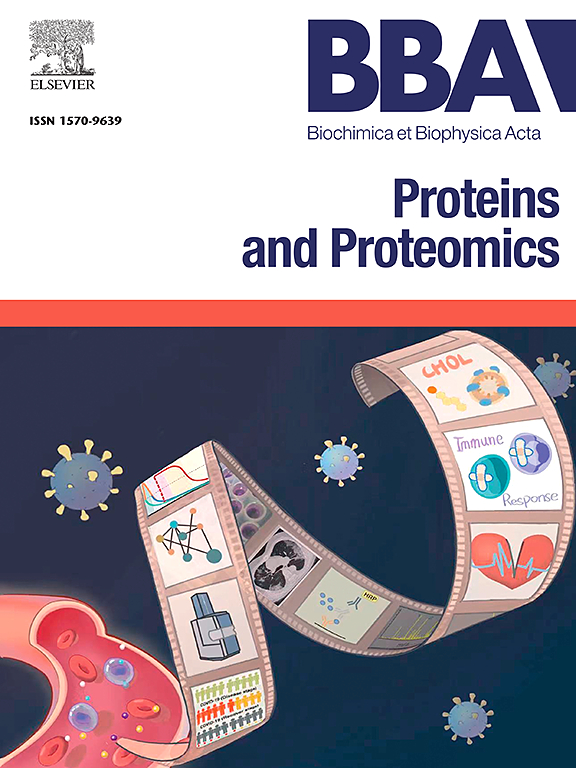DNAJBs在蛋白质聚集和相关神经退行性疾病中的结构功能相关性
IF 2.3
4区 生物学
Q3 BIOCHEMISTRY & MOLECULAR BIOLOGY
Biochimica et biophysica acta. Proteins and proteomics
Pub Date : 2025-04-18
DOI:10.1016/j.bbapap.2025.141074
引用次数: 0
摘要
DNAJ蛋白,也被称为hsp40,是调节hsp70在维持细胞蛋白稳态中的多功能性的共同伴侣。DNAJ co-chaperones的异质家族被分为A、B和C三类,该类内的结构多样性决定了它们的特定功能。在这三类中,DNAJB类共伴侣蛋白与细胞区室特异性蛋白质折叠、分解和降解有关,并能有效靶向广谱的易聚集底物蛋白。DNAJBs的结构差异是通过与HSP70和底物蛋白的特异性相互作用来调节分解和降解功能的关键。虽然dnajb在维持蛋白质稳态中的作用在解决神经退行性疾病的蛋白质聚集方面是有价值的,但对其机制和细胞功能的有限理解限制了它们的治疗应用。本文就dnajb调控α-突触核蛋白、tau蛋白、淀粉样蛋白-β和亨廷顿蛋白等致病性蛋白聚集的机制进行了综述。重点介绍了DNAJB对HSP70的折叠、分解和降解功能的选择性,底物选择和不同结构区域的参与,以提供对DNAJB蛋白的结构和功能的理解。不同的DNAJBs突变与几种蛋白质聚集相关的神经元和神经肌肉疾病进行了讨论。对DNAJB多样性和功能的基本了解有助于未来干预调节蛋白质稳态和管理相关疾病。本文章由计算机程序翻译,如有差异,请以英文原文为准。
Structural-functional relevance of DNAJBs in protein aggregation and associated neurodegenerative diseases
DNAJ proteins, also known as HSP40s, are co-chaperones that regulate the multifunctionality of HSP70s in maintaining cellular protein homeostasis. The heterogeneous family of DNAJ co-chaperones is classified into three classes (A, B and C), where structural diversity within the class defines their specific functions. Among three classes, the DNAJB class of co-chaperones are associated with cellular compartment-specific protein folding, disaggregation and degradation of proteins and enables effective targeting of a broad spectrum of aggregation-prone substrate proteins. The structural divergence of DNAJBs is critical for regulating disaggregation and degradation functions through specific interactions with HSP70 and substrate proteins. While the role of DNAJBs in maintaining protein homeostasis is valuable in addressing protein aggregation in neurodegenerative diseases, a limited understanding of their mechanisms and cellular functions beyond co-chaperones restricts their therapeutic applications. In this review, the mechanism of DNAJBs regulating aggregation of pathogenic proteins such as α-synuclein, tau, amyloid-β, and huntingtin are discussed. Emphasis on the selectivity of DNAJBs towards folding, disaggregation and degradation functions of HSP70, substrate selection and involvement of different structural regions are explained to provide a structural and functional understanding of DNAJB proteins. Mutations in different DNAJBs linked with several proteins aggregation-related neuronal and neuromuscular diseases are discussed. The fundamental understanding of DNAJB diversity and functionality can assist future interventions for regulating protein homeostasis and managing associated diseases.
求助全文
通过发布文献求助,成功后即可免费获取论文全文。
去求助
来源期刊
CiteScore
8.00
自引率
0.00%
发文量
55
审稿时长
33 days
期刊介绍:
BBA Proteins and Proteomics covers protein structure conformation and dynamics; protein folding; protein-ligand interactions; enzyme mechanisms, models and kinetics; protein physical properties and spectroscopy; and proteomics and bioinformatics analyses of protein structure, protein function, or protein regulation.

 求助内容:
求助内容: 应助结果提醒方式:
应助结果提醒方式:


